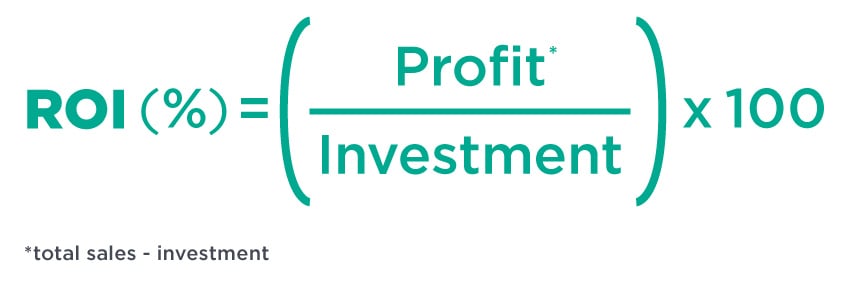Return on investment (ROI) measures investment performance. It calculates the profit as a percentage of the initial investment amount. A positive ROI means you will make more money than you invested. ROI can be the critical difference between ugly debt and positive growth.
Why bother calculating ROI?
Running a business is exhausting, so why should you take time out of your over-packed schedule to dredge up your high school maths knowledge? Because ROI can give you a precious insight into the potential return from your risk. Calculating the ROI on a business loan can indicate how much growth opportunity lies ahead. In this piece, we’ll take you through why calculating ROI is important, how to do it, and show some different examples. Remember, calculating ROI might just be the difference between taking on ugly debt and taking your business growth to the next level.
Risk versus return
It can be difficult to account for risk when calculating ROI. But if you haven’t calculated the total cost of your investment and the potential profit, how can you tell whether the risk is worth the gamble? Risk appetite is highly personal and you need to make a decision that’s right for your business circumstances. There will always be a need for working capital. Having working capital can let you take advantage of the less risky investments like buying a bulk order to take advantage of economy of scale or seasonal discounts. Restricted cash flow can make it difficult to produce working capital upfront, and that’s where a business loan can help your business grow.

The difference between good, bad, and ugly debt
When it comes to growing your business, it’s important to differentiate the different types of debt. Saying all debt is bad is an oversimplification and could limit your growth potential. Restricted cash flow is not only frustrating, but it can also be devastating to the success of your business. That’s why it’s helpful to identify the three different types of debt: good, bad, and ugly.
Good debt
Good debt is tied to a positive ROI. This means the cost of the loan or investment costs less than the value you get out of it. For example, if you take out a loan that totals $20,000 for a business opportunity that increases sales by $60,000, that’s a good investment using good debt well.
Bad debt
Bad debt is any debt that costs more than you get out of it, also known as negative ROI. For example, if you take out a loan that totals $20,000 for a business opportunity that increases sales by $10,000, that’s a bad investment. [Note: We’re not referring to dad debt in the accounting sense, which is accounts receivable that will not be collected for whatever reason.] Bad debt is often taken on to cover sudden expenses or to purchase items that rapidly lose their value. Good debt can also turn bad if the debtor has no strategy to pay it off. You can help prevent good debt from becoming bad debt by estimating the potential ROI of ahead of time.
Ugly debt
Ugly debt is bad debt that’s run out of control and into the hands of debt collectors. Obviously, good debt can turn bad and then become ugly – and quickly too. An overdue invoice can quickly spiral out of control to the point of incessant phone calls from debt collectors asking for the original debt plus their administrative fees, and interest. The key to quashing ugly debt is addressing bad debt early on. If you estimate the ROI of an investment, calculate a conservative timeline and plan for how you will repay your loan, you can avoid taking on bad debt. If your debt does turn bad, ensure you contact the lender early – before you default on repayments – and set up a payment plan. This will save you a lot of stress and potentially a lot of money in dishonour penalties.
To learn more about these different types of debt, and how to stop good, going bad, and bad turning ugly, read the in-depth debt article.
Calculating ROI
Calculating ROI is quite simple. The hardest part is estimating the net profit you stand to make from your investment. The formula is: ROI(%) = (Net profit / Investment) x 100. The answer is a percentage of your initial investment.

The ROI Calculator
It’s easy to get excited about a growth opportunity that could boost your profits or take your business to the next level. But don’t let excitement cloud your calculations. Remember that your ROI could be the difference between taking on good debt and positive growth for your business, or ugly debt and an ongoing struggle with creditors. Use our Business Loan Calculator to see the total cost of a loan, then calculate ROI to estimate the return on your investment.
Here are some practical examples of how ROI can look for different businesses.
Example 1 – Calculating ROI on an inventory investment
You have the chance to purchase inventory at a 40% discount for a total of $200,000. Assume you can resell this stock for $600,000 and Moula lends you $200,000 on a six-month term at 1% interest rate per fortnight.
The total cost of your loan including interest is $214,279. Minus the investment from the total revenue and you have a profit of $385,271. Using the ROI formula you can estimate the ROI to be 180%.
Example 2 – Calculating ROI on a marketing campaign
You’re planning a marketing campaign that will cost $150,000. You know your customer lifetime value is $5,000, and you anticipate earning 100 new customers. Moula lends you $150,000 on a 6-month term at 1.5% interest per fortnight.
The total cost of your loan including interest is $166,219. Minus the investment from the total revenue and you have a profit of $333,781. Using the ROI calculator you can estimate the ROI to be 201%.

Example 3 – Calculating ROI on an equipment investment
You need to buy a new truck, which will set you back $80,000 and has an estimated lifetime of 5 years. You know it will be able to increase efficiencies across your business and you’ve estimated it will increase annual sales $150,000. Moula lends you $80,000 on a 6-month term at 1% interest per fortnight.
The total cost of your loan including interest is $85,711. Minus the investment from the total revenue and you have a profit of $664,289. Using the ROI calculator you can estimate the ROI to be 775%.
The critical difference between profit and cash flow
When calculating ROI, and contemplating an exciting growth opportunity, it’s easy to forget the critical difference between profit and cash flow – wily business owners know the difference, and associated challenges and threats all too well. The critical difference is timing, which really is everything when it comes to cash flow. You may net a huge ROI and a healthy profit, but there’s a massive difference between earning a profit of $162, 889 in one week, versus one year or longer. In the long term, your business will benefit from the investment. But if it will take 12 months for you to reach that profit prediction, your cash flow is likely to suffer. Remember to consider the implications your investment may have on your cash flow. Read on to see how a business loan can help you overcome this challenging aspect to business investment.
How a Business Loan Can Help Your ROI
A business loan can be used for just about any business need you may have including inventory, overheads, consolidating business debt and staffing. When it comes to ROI, a business loan can help in two simple ways:
- It can act as working capital to fund the initial investment, or
- It can cover cash flow while you wait for the profit from your investment flow into your cash stream.

1. Using a business loan as investment capital
If you need working capital to make the most of your investment, a business loan can help. Many opportunities come with a tight deadline, which means traditional funding options (like the big four banks) aren’t viable. Fortunately, you can secure funds up to $250,000 from Moula in as little as 24 hours, and the application only takes 10 minutes.
But before you take out a loan, it’s important to ensure your investment will still net you a positive ROI. Because we believe in transparent lending, we don’t charge any hidden fees, so using our business loan calculator will give you an accurate estimate of the total cost of a loan. You can then use that figure to estimate your ROI – just one of the ways we’re helping good businesses grow.
2. Using a business loan to help cash flow after investment
Some businesses will have enough working capital to invest in their business without seeking finance. The challenge can arise after the investment when cash flow is throttled because the business owner miscalculated how quickly the new profits would come in. Cash flow challenges are all too common for business owners, especially small business owners and newer businesses – that’s where Moula can help. Business loans can be a cost-effective way to overcome cash flow challenges. If you need working capital to cover overheads, wages or other cash flow challenges, then a business loan can help.
Here’s an example of how a business loan can help with cash flow and still keep your ROI positive.
Example of cash flow challenges with profit
You have an opportunity to invest in new equipment that will cost $100,000, and you estimate it will increase your revenue by $200,000 over the next 2 years. You have the working capital to cover the initial investment and you’ve estimated your ROI over the two years is 100%. That looks great at face value, but that’s 50% annual return – still a great ROI, but those profits could easily be taken up by operating costs, other unexpected costs or new overheads. While it doesn’t mean your investment is a bad decision, nor has it turned your good debt into bad debt, it might create cash flow challenges that could have a knock-on effect to create even more challenges the following year. And all this despite a good looking ROI.
A business loan can help bridge cash flow and still leave a strong ROI. You decide to take out a business loan to cover your cash flow until the profits from your investment come through. You’re approved for a $60,000 loan with Moula on a 12-month term with 1% interest rate charged fortnightly. Because you used our Business Loan Calculator, you know the total cost of your loan is $68,435. So your first-year profit from your investment is $100,000 minus the total interest you pay on the business loan, which is $8,435. So your profit from your investment is still $91,565 and your cash flow challenges are taken care of too. As you can see, our Business Loan Calculator can help in more ways than one, just like our transparent business loans.




